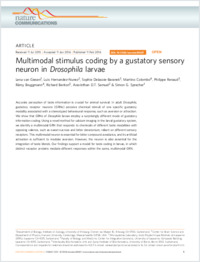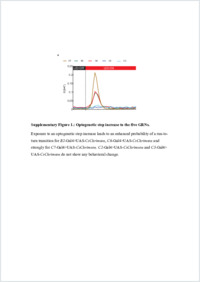Multimodal stimulus coding by a gustatory sensory neuron in Drosophila larvae
- Giesen, Lena van Department of Biology, Institute of Zoology, University of Fribourg, Switzerland
- Hernandez-Nunez, Luis Center for Brain Science and Department of Physics, Harvard University, Cambridge, USA
- Delasoie-Baranek, Sophie Microsystems Laboratory, Ecole Polytechnique Fédérale de Lausanne (EPFL), Switzerland
- Colombo, Martino Interfaculty Bioinformatics Unit and Swiss Institute of Bioinformatics, University of Berne, Switzerland
- Renaud, Philippe Microsystems Laboratory, Ecole Polytechnique Fédérale de Lausanne (EPFL), Switzerland
- Bruggmann, Rémy Interfaculty Bioinformatics Unit and Swiss Institute of Bioinformatics, University of Berne, Switzerland
- Benton, Richard Faculty of Biology and Medicine, Center for Integrative Genomics, University of Lausanne, Switzerland
- Samuel, Aravinthan D.T. Center for Brain Science and Department of Physics, Harvard University, Cambridge, USA
- Sprecher, Simon G. Department of Biology, Institute of Zoology, University of Fribourg, Switzerland
-
11.02.2016
Published in:
- Nature Communications. - 2016, vol. 7, p. 10687
English
Accurate perception of taste information is crucial for animal survival. In adult Drosophila, gustatory receptor neurons (GRNs) perceive chemical stimuli of one specific gustatory modality associated with a stereotyped behavioural response, such as aversion or attraction. We show that GRNs of Drosophila larvae employ a surprisingly different mode of gustatory information coding. Using a novel method for calcium imaging in the larval gustatory system, we identify a multimodal GRN that responds to chemicals of different taste modalities with opposing valence, such as sweet sucrose and bitter denatonium, reliant on different sensory receptors. This multimodal neuron is essential for bitter compound avoidance, and its artificial activation is sufficient to mediate aversion. However, the neuron is also essential for the integration of taste blends. Our findings support a model for taste coding in larvae, in which distinct receptor proteins mediate different responses within the same, multimodal GRN.
- Faculty
- Faculté des sciences et de médecine
- Department
- Département de Biologie
- Language
-
- English
- Classification
- Biological sciences
- License
-
License undefined
- Identifiers
-
- RERO DOC 258807
- DOI 10.1038/ncomms10687
- Persistent URL
- https://folia.unifr.ch/unifr/documents/304889
Other files
Statistics
Document views: 126
File downloads:
- pdf: 198
- Supplementary Figures 1-6 and Supplementary Tables 1-2: 116
- RNA seq information of sensory receptor genes: 44


